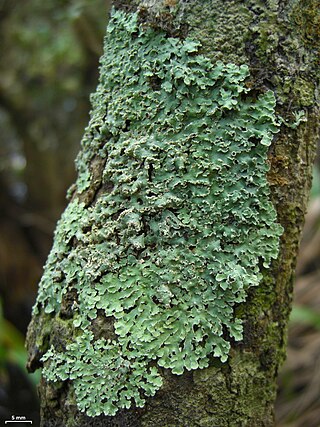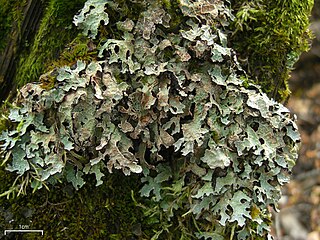
Flavoparmelia baltimorensis, the rock greenshield lichen, is a medium to large foliose lichen with a yellow green upper thallus surface when dry; its lobes are rounded without pseudocyphellae; and the upper surface is covered with globose, pustule-like growths resembling isidia. The lower surface is black with a narrow brown zone at the margins.

Pyxine is a genus of foliose lichens in the family Caliciaceae. The genus has a widespread distribution in tropical regions.

Physcia is a genus of lichen-forming fungi in the family Physciaceae. The widely distributed genus contains about 80 species. The genus is cosmopolitan, and has been extensively studied in various regions in the past several decades, with significant biodiversity in South America identified as a central diversity hotspot. Physcia species are foliose, lobate lichens that grow with a loose to close appressed habit. Their upper surface is typically whitish, pale greenish, green-grey, or dark grey in colour. The thallus colour remains relatively unchanged when moistened. Physcia lichens typically grow on bark, on wood, or rock, although they have occasionally been recorded dwelling on man-made structures. They thrive in nutrient-rich environments and are expanding rapidly in urban areas of the United Kingdom previously affected by SO2 pollution.

Esslingeriana is a fungal genus in the family Parmeliaceae. The genus is monotypic, containing the single foliose lichen species Esslingeriana idahoensis, commonly known as the tinted rag lichen. It is found in northwestern North America.

Pyxine cocoes, the buttoned rosette lichen, is a widely distributed species of foliose lichen in the family Caliciaceae.

Pyxine subcinerea is a species of foliose lichen in the family Caliciaceae. It has a pantropical distribution, and typically grows on bark, but less commonly on rocks. The lichen is characterised by its yellow medulla, soralia on the margins on the lobes that make up the thallus, and the presence of the chemical lichexanthone in the cortex.

Punctelia hypoleucites, commonly known as the southwestern speckled shield lichen, is a species of foliose (leafy) lichen in the family Parmeliaceae. First formally described by Finnish botanist William Nylander as a species of Parmelia, it was transferred to the genus Punctelia in 1982. The lichen is found in Africa, North America, and South America, where it grows on the bark of both hardwood and coniferous trees. Its greenish-grey thallus is covered with tiny white pseudocyphellae – minute holes in the thallus surface that facilitate gas exchange. Some macroscopic features that help distinguish this species from other related members of the genus include the presence and the structure of the apothecia, the absence of asexual surface propagules, and the light brown color of the thallus undersurface. Chemically, the presence of lecanoric acid in the medulla and atranorin in the cortex help distinguish it from lookalikes.

Punctelia perreticulata is a widely distributed species of foliose lichen in the family Parmeliaceae. It occurs in Mediterranean Europe and Russia, North America, South America, Australia, and New Zealand, where it grows on rocks, bark, or wood. Its main distinguishing features are its thallus surface, marked with many shallow depressions, grooves, or pits, and sorediate pseudocyphellae. The lower side of the thallus is ivory to tan towards the centre and the major secondary metabolite in the medulla is lecanoric acid. A lookalike species with which it has been historically confused is Punctelia subrudecta; this lichen can be distinguished from Punctelia perreticulata by the texture of the thallus surface, or, more reliably, by the length of its conidia.

Cetrelia chicitae is a species of foliose lichen in the family Parmeliaceae. It is found in eastern Asia, North America, and Europe, where it grows on mossy rocks and tree trunks.

Punctelia borreri is a species of foliose lichen in the family Parmeliaceae. It is a common and widely distributed species, occurring in tropical, subtropical, and temperate regions of Africa, Asia, Europe, North America, Oceania, and South America. The lichen typically grows on bark of deciduous trees, and less commonly on rock. Some European countries have reported increases in the geographic range or regional frequency of the lichen in recent decades, attributed alternatively to a reduction of atmospheric sulphur dioxide levels or an increase in temperatures resulting from climate change.

Parmelia barrenoae is a species of foliose lichen in the large family Parmeliaceae. It was formally described as a new species in 2005. Before this, it was lumped together as one of several lichens in the Parmelia sulcata group—a species complex of genetically distinct lookalikes. Parmelia barrenoae is widely distributed, occurring in Europe, western North America, Africa, and Asia.

Parmelia fraudans is a species of foliose lichen in the family Parmeliaceae. It is found in Europe and North America, where it grows on rocks.

Pyxine albovirens is a species of foliose lichen in the family Caliciaceae that is found in North America and South America. It was first formally described as a species of Lecidea in 1818 by German botanist Georg Friedrich Wilhelm Meyer. André Aptroot transferred it to the genus Pyxine in 1987.
Pyxine katendei is a species of corticolous (rock-dwelling), foliose lichen in the family Caliciaceae. Found in East Africa, it was scientifically described as a new species in 1975 by lichenologists Dougal Swinscow and Hildur Krog. The lichen has a whitish to pale grey thallus that is tightly appressed to its substrate. The lobes comprising the thallus are somewhat convex; they lack pseudocyphellae, and have sparse pruina. The thallus underside is black; the internal medulla is white. The lichen contains triterpenoid compounds as well as lichexanthone; the latter substance causes the lichen to fluoresce when lit with a long-wavelength UV light.
Pyxine lilacina is a rare species of saxicolous (rock-dwelling), foliose lichen in the family Caliciaceae. Found in East Africa, it was scientifically described as a new species in 1975 by lichenologists Dougal Swinscow and Hildur Krog. The lichen has a brownish-grey to lilac-grey thallus that is tightly appressed to its substrate. The lobes comprising the thallus are flat, and have pseudocyphellae as well as patches of pruina. The thallus underside is black; the internal medulla is white. The lichen contains triterpenoid compounds as well as lichexanthone; the latter substance causes the lichen to fluoresce when lit with a long-wavelength UV light.
Hypogymnia capitata is a species of foliose lichen in the family Parmeliaceae. Found in high-elevation conifer forests in Sichuan Province, China, it was described as a new species in 2014. The lichen is characterized by its capitate terminal soralia, brownish lobes with white cavities, and the presence of olivetoric acid. This lichen is distinguished from similar species by its specific morphological, chemical, and habitat characteristics.

Leproplaca cirrochroa is a widespread and common species of saxicolous (rock-dwelling), crustose lichen in the family Teloschistaceae. It grows up to 5 cm across, featuring a placodioid thallus with narrow, finger-like lobes that adhere closely to the surface, showing intricate division and ranging in colour from dirty orange to brownish orange, often with paler, pruinose orange ends.
Pyxine profallax is a species of corticolous (bark-dwelling), foliose lichen in the family Caliciaceae. It is found in Australia, Papua New Guinea, and Thailand.

Pyxine petricola is a species of saxicolous (rock-dwelling), foliose lichen in the family Caliciaceae. The distribution of the lichen includes Australia, East Africa, North and Central America, and the Philippines.
Awasthia is a monotypic fungal genus in the family Physciaceae. It contains the single species Awasthia melanotricha, a foliose lichen found in the Nepal Himalayas.















